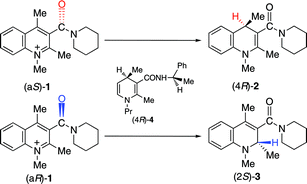Consideration of molecular arrangements in regio- and enantioselective reduction of an NAD model compound controlled by carbonyl oxygen orientation†‡
Abstract
The regio- and enantioselectivity of the reduction of an

* Corresponding authors
a
KYOUSEI Science Center, Nara Women's University, Nara 630-8506, Japan
E-mail:
mikata@cc.nara-wu.ac.jp
b Division of Functional Material Science, Nara Women's University, Nara 630-8506, Japan
The regio- and enantioselectivity of the reduction of an

 Please wait while we load your content...
Something went wrong. Try again?
Please wait while we load your content...
Something went wrong. Try again?
Y. Mikata, S. Aida, Y. Inaba and S. Yano, Org. Biomol. Chem., 2007, 5, 3834 DOI: 10.1039/B710780C
To request permission to reproduce material from this article, please go to the Copyright Clearance Center request page.
If you are an author contributing to an RSC publication, you do not need to request permission provided correct acknowledgement is given.
If you are the author of this article, you do not need to request permission to reproduce figures and diagrams provided correct acknowledgement is given. If you want to reproduce the whole article in a third-party publication (excluding your thesis/dissertation for which permission is not required) please go to the Copyright Clearance Center request page.
Read more about how to correctly acknowledge RSC content.
 Fetching data from CrossRef.
Fetching data from CrossRef.
This may take some time to load.
Loading related content
